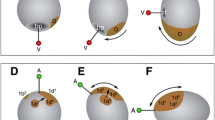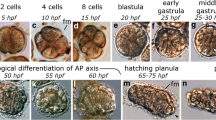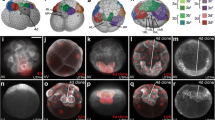Abstract
The moon jellyfish Aurelia exhibits a dramatic reorganization of tissue during its metamorphosis from planula larva to polyp. There are currently two competing hypotheses regarding the fate of embryonic germ layers during this metamorphosis. In one scenario, the original endoderm undergoes apoptosis and is replaced by a secondary endoderm derived from ectodermal cells. In the second scenario, both ectoderm and endoderm remain intact through development. In this study, we performed a pulse-chase experiment to trace the fate of larval ectodermal cells. We observed that prior to metamorphosis, ectodermal cells that proliferated early in larval development concentrate at the future oral end of the polyp. During metamorphosis, these cells migrate into the endoderm, extending all the way to the aboral portion of the gut. We therefore reject the hypothesis that larval endoderm remains intact during metamorphosis and provide additional support for the “secondary gastrulation” hypothesis. Aurelia appears to offer the first and only described case where a cnidarian derives its endoderm twice during normal development, adding to a growing body of evidence that germ layers can be dramatically reorganized in cnidarian life cycles.



Similar content being viewed by others
References
Davidson EH, Peterson KJ, Cameron RA (1995) Origin of bilaterian body plans: evolution of developmental regulatory mechanisms. Science 270:1319–1325
Dawson MN, Jacobs DK (2001) Molecular evidence for cryptic species of Aurelia aurita (Cnidaria, Scyphozoa). Biol Bull 200:92–96
De Velasco B, Shen J, Go S, Hartenstein V (2004) Embryonic development of the Drosophila corpus cardiacum, a neuroendocrine gland with similarity to the vertebrate pituitary, is controlled by sine oculis and glass. Dev Biol 274:280–294
Fioroni V (1979) Abändarungen des Gastrulationsverlaufs und ihre phylogenetische Bedeutung. In: Suewing R (ed) Erlanger Symp. Ontogenie Evolutionsforsch: Ontogenie unid Phylogenie. Parey, Hamburg, pp 100–119
Fritzenwanker JH, Genikhovich G, Kraus Y, Technau U (2007) Early development and axis specification in the sea anemone Nematostella vectensis. Dev Biol 310:264–279
Fuchs J, Martindale MQ, Hejnol A (2011) Gene expression in bryozoan larvae suggest a fundamental importance of pre-patterned blastemic cells in the bryozoan life-cycle. EvoDevo 2:1
Gold DA, Nakanishi N, Hensley NM et al (2015) Structural and developmental disparity in the tentacles of the moon jellyfish Aurelia sp.1. PLoS ONE 10:e0134741
Gold DA, Jacobs DK (2013) Stem cell dynamics in Cnidaria: are there unifying principles? Dev Genes Evol 223(1-2):53–66
Helm RR, Tiozzo S, Lilley MKS et al (2015) Comparative muscle development of scyphozoan jellyfish with simple and complex life cycles. EvoDevo 6:11
Hyde JH (1894) Entwicklungsgeschichte einiger Scyphomedusen. Z Wiss Zool 58:531–565
Kraus JEM, Fredman D, Wang W et al (2015) Adoption of conserved developmental genes in development and origin of the medusa body plan. EvoDevo 56:753–777
Maslakova SA (2010) Development to metamorphosis of the nemertean pilidium larva. Front Zool 7:30
Mayorova TD, Kosevich IA, Melekhova OP (2012) On some features of embryonic development and metamorphosis of Aurelia aurita (Cnidaria, Scyphozoa). Russ J Dev Biol 43:271–285
Martín-Durán JM, Egger B (2012) Developmental diversity in free-living flatworms. EvoDevo 3:1
Martindale M, Hejnol A (2009) A developmental perspective: changes in the position of the blastopore during bilaterian evolution. Dev Cell 17:162–174
Mergner H (1971) Chapter 1: cnidaria. In: Reverberi G (ed) Experimental embryology of marine and fresh-water invertebrates. North Holland, Amsterdam, pp 1–84
Morris J, Nallur R, Ladurner P, Egger B, Rieger R, Hartenstein V (2004) The embryonic development of the flatworm Macrostomum sp. Dev Genes Evol 214:220–239
Nakanishi N, Yuan D, Jacobs DK, Hartenstein V (2008) Early development, pattern, and reorganization of the planula nervous system in Aurelia (Cnidaria, Scyphozoa). Dev Genes Evol 218:511–524
Pennati R, Dell’Anna A, Pagliara P et al (2013) Neural system reorganization during metamorphosis in the planula larva of Clava multicornis (Hydrozoa, Cnidaria). Zoomorphology 132:227–237
Seipp S, Schmich J, Leitz T (2001) Apoptosis—a death-inducing mechanism tightly linked with morphogenesis in Hydractina echinata (Cnidaria, Hydrozoa). Development 128:4891–4898
Seipp S, Schmich J, Will B et al (2010) Neuronal cell death during metamorphosis of Hydractina echinata (Cnidaria, Hydrozoa). Invert Neurosci 10:77–91
Smith F (1891) The gastrulation of Aurelia flavidula, Pér. & Les. Bull Museum Comparat Zool Harvard College 22:115–125
Takashima S, Gold D, Hartenstein V (2013) Stem cells and lineages of the intestine: a developmental and evolutionary perspective. Dev Genes Evol 223:85–102
Temereva EN, Malakhov VV (2015) Metamorphic remodeling of morphology and the body cavity in Phoronopsis harmeri (Lophotrochozoa, Phoronida): the evolution of the phoronid body plan and life cycle. BMC Evol Biol 15:1
Yuan D, Nakanishi N, Jacobs DK, Hartenstein V (2008) Embryonic development and metamorphosis of the scyphozoan Aurelia. Dev Genes Evol 218:525–539
Acknowledgments
This work was supported by funding from the NASA Astrobiology Institute (NNA13AA90A) Foundations of Complex Life, Evolution, Preservation, and Detection on Earth and Beyond.
Author information
Authors and Affiliations
Corresponding author
Additional information
Communicated by Angelika Stollewerk
Rights and permissions
About this article
Cite this article
Gold, D.A., Nakanishi, N., Hensley, N.M. et al. Cell tracking supports secondary gastrulation in the moon jellyfish Aurelia . Dev Genes Evol 226, 383–387 (2016). https://doi.org/10.1007/s00427-016-0559-y
Received:
Accepted:
Published:
Issue Date:
DOI: https://doi.org/10.1007/s00427-016-0559-y




